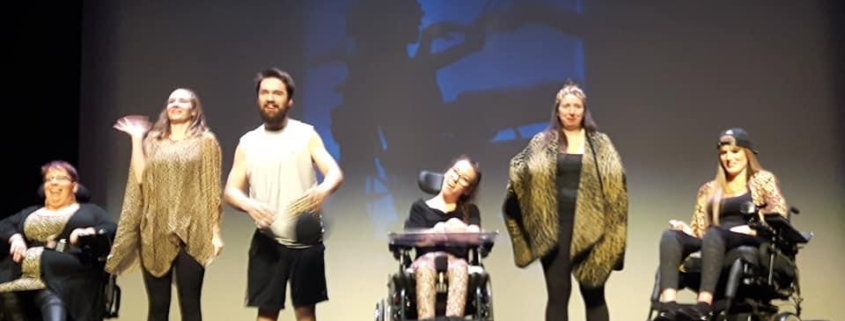Interrupting Ableism in the Arts Sector: Part 2
The Cost of Exclusion
This is the Second of three articles in the series Interrupting Ableism by Deb Nyczai. This edition focuses on the cost of exclusion. The first, Interrupting Ableism in the Arts can be found here.
 In Part 1 of this series, we examined how ableism manifests in the arts sector, creating systemic barriers that silence and exclude disabled artists. But exclusion doesn’t just harm individual artists—it weakens the entire arts ecosystem.
In Part 1 of this series, we examined how ableism manifests in the arts sector, creating systemic barriers that silence and exclude disabled artists. But exclusion doesn’t just harm individual artists—it weakens the entire arts ecosystem.
The arts thrive on diversity of thought, experience, and expression. Yet, when disabled artists are excluded from funding, leadership, and programming, the sector suffers from a lack of innovation, a shrinking audience base, and financial loss.
Ignoring accessibility is not just an ethical issue—it’s an economic and creative failure.
The Creative Loss: What We Miss When Disabled Artists Are Excluded
Art is about expanding perspectives, challenging norms, and offering new ways of experiencing the world. Disabled artists bring unique lived experiences and creative practices that reshape how we think about storytelling, movement, sound, and space.
Yet, when the arts sector fails to remove access barriers, it robs itself of innovation.
Revolutionizing Art Forms
- Some of the most groundbreaking artistic innovations have come from disabled artists pushing against traditional boundaries:
Deaf artists have transformed dance and performance by incorporating visual rhythm and movement that challenges conventional ideas of music. - Neurodivergent creators have expanded storytelling structures, offering alternative ways to experience narrative, time, and emotion.
Artists with mobility disabilities have redefined choreography, bringing new perspectives on movement and physicality to the stage. - Disability-led artistic movements have reshaped industries, but many of these contributions are overlooked—or dismissed as niche. Why? Because the arts sector continues to center non-disabled perspectives as the default. By failing to actively include and fund disabled artists, the industry limits its own creative potential.
The Audience Gap: Who Gets Left Out?
Ableism in the arts doesn’t just exclude disabled artists—it alienates disabled audiences and those who support them. In Canada, more than 6 million people live with disabilities—roughly 22% of the population. That’s millions of potential audience members who are often unable to attend performances, exhibits, and cultural events due to physical, financial, and sensory barriers. The exclusion also impacts caregivers, support workers, and family members who accompany or assist disabled individuals. When accessibility isn’t considered, an entire circle of potential patrons is shut out.
Why This Matters
When arts organizations fail to prioritize accessibility, they lose a major demographic of attendees, subscribers, and patrons.
- A theater without captioning or ASL interpretation is inaccessible to Deaf and hard-of-hearing audiences.
- A gallery without descriptive audio tours excludes blind and low-vision visitors.
- A festival without flexible seating, sensory-friendly spaces, or accessible transit options shuts out disabled people entirely.
The result? Lower attendance, lost revenue, and a reputation for exclusion.
Some arts organizations assume that making accessibility a priority will only benefit a small minority of people. The truth is, accessible design benefits everyone.
- Parents with strollers benefit from ramps and elevators.
- Older adults benefit from captioning and clear audio.
- People recovering from injuries or illnesses benefit from accessible seating and flexible programming.
Accessibility isn’t an “extra.” It’s a necessary investment that expands audience reach.
The Economic Cost: How Inaccessibility Hurts the Industry
The arts sector often argues that accessibility is too expensive to implement. But failing to invest in accessibility costs more in the long run.
1. Lost Funding Opportunities
Many funding bodies, including government agencies and private foundations, are shifting toward prioritizing accessibility and inclusion in their grant criteria. Organizations that fail to demonstrate meaningful accessibility efforts may find themselves losing out on critical funding. In contrast, organizations that integrate accessibility from the outset often gain:
- Larger grant opportunities
- Corporate sponsorships aligned with diversity, equity, and inclusion (DEI) initiatives
- Increased ticket sales and membership retention from a broader audience base
2. Shrinking Donor and Sponsor Interest
Philanthropy is changing. Many donors and sponsors now seek organizations that demonstrate a real commitment to equity. An arts organization that actively excludes disabled artists and audiences is not aligned with the values of modern funders.
Businesses want to be associated with inclusivity, not exclusion.
3. Legal and Reputational Risks
Inaccessibility is not just an ethical failure—it’s a legal liability.
In Saskatchewan, two key legal frameworks now govern accessibility:
- The Saskatchewan Human Rights Code, which prohibits discrimination based on disability and requires reasonable accommodation unless it causes undue hardship.
- The Accessible Saskatchewan Act (2023), which sets new province-wide accessibility standards across sectors, including public spaces, events, and programs. This legislation establishes clear obligations for organizations to remove and prevent barriers.
Failure to comply with these laws can result in:
- Human rights complaints
- Penalties or enforcement actions under the new Act
- Reputational damage and public backlash, especially in a digital era where exclusionary practices are amplified quickly
Proactively investing in accessibility is not just compliance—it’s about leadership, trust, and long-term sustainability.
Examples of Success: What Happens When the Arts Get It Right?
Despite widespread inaccessibility, some arts organizations are leading the way in prioritizing disabled artists and audiences:
- Listen to Dis’ (LTD), Saskatchewan’s only disability-led arts organization, has created groundbreaking performances, workshops, and accessibility audits, proving that inclusive arts practices enhance – not limit – artistic expression.
- The National Theatre in the UK offers relaxed performances, audio-described shows, and accessible ticketing, expanding their audience reach significantly.
- The Stratford Festival in Ontario has increased its investment in ASL interpretation, audio description, and relaxed performances, making theater more inclusive.
These organizations did not wait for legal mandates—they recognized that investing in accessibility is a long-term gain for artistic excellence, audience engagement, and financial sustainability.
Moving Forward: What Needs to Change?
If the arts sector wants to remain culturally relevant, financially sustainable, and artistically innovative, accessibility must be at the core of its operations—not an afterthought.
This means:
✅ Funding bodies prioritizing accessibility grants and resources
✅ Arts organizations embedding access into programming from the start
✅ Hiring disabled artists, leaders, and decision-makers
✅ Implementing universal design principles in venues and events
✅ Marketing and outreach efforts that actively engage disabled audiences
The cost of exclusion is simply too high. The arts cannot afford to continue shutting out disabled artists and audiences.
In Part 3 of this series, we will explore what true accessibility in the arts looks like and how the sector can move beyond compliance to create a culture of true inclusion.
Deb Nyczai is a strategic leader and consultant specializing in government relations, policy development, and communications. With a Master of Public Administration (MPA) specializing in Public Management from the Johnson Shoyama Graduate School of Public Policy, she builds partnerships and advocates for community and economic outcomes through innovative strategies. Deb offers specialized consulting services to nonprofits and small businesses alongside her full-time role as Executive Director of Listen to Dis’ (LTD’), Saskatchewan’s first and only not-for-profit, disability-led disability arts organization. She is passionate about human rights, community development, and fostering meaningful change.
Connect with Deb on LinkedIn: linkedin.com/in/deb-nyczai-mpa-5474126a


